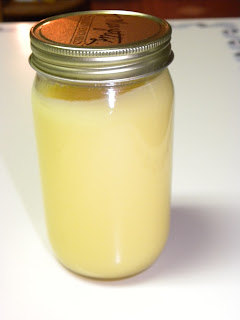1. In a stainless steel heavy pot add the whipped butter or butter sticks
2. Once the Ghee begins to boil, turn it down to the lowest flame at which it will continue to boil. As it boils, moisture evaporates off it and it will begin to “clarify”- the butter will
turn from cloudy yellowish liquid to a more golden color.
turn from cloudy yellowish liquid to a more golden color.
| step 2 |
Whitish cloudy milk solids will rise to the top and
sink to the bottom.
3. After 10-15 minutes it clarifies and you will see
debris on the bottom of the pot. After the Ghee is done,
you skim off the top light crust of whitish milk solids.
These and the heavier ones at the bottom of the pot
are traditionally used to make sweets.
you skim off the top light crust of whitish milk solids.
These and the heavier ones at the bottom of the pot
are traditionally used to make sweets.
Then, you pour the golden, sweet-smelling liquid
through layered cheesecloth- or fine mesh sieve to
through layered cheesecloth- or fine mesh sieve to
| step 3 |
catch any last impurities into a bottle,
leaving the slightly burned milk solids (caramelized lactose)
on the bottom of the pot you cooked it in (Ghee has no lactose or milk sugars in it).
4. Let it cool down for 15-20 minutes.
5. Store it in a cool dry place. Be sure to not close the glass jar into which you pour the hot Ghee until it comes to room temperature.The reason for this is that there should not be
| step 4 |
any moisture from condensation that may form on the
inside of the jar. It is moisture that spoils Ghee, allowing a mold to grow and causing it to go bad.
This is the reason that you always use a clean and dry spoon to take your Ghee out of its container. It is also a reason not to refrigerate your Ghee. One, because it is not necessary and two, it causes condensation to form inside the jar as you take it in and out of the refrigerator
CAUTION- Do not stir it. After an hour and half to several hours, depending on the amount and the size of the pot and the amount of Ghee compared to the flame, your Ghee will be ready. The moment Ghee is “ready” is very critical. If you cook the Ghee too little, you will be left with moisture in the Ghee and it will lack the exquisite taste and qualities that it can develop, also, it will tend to spoil or sour. If you cook it too much, it will burn and impart a certain nutty flavor to the Ghee. This does not ruin the Ghee at all, but it is to be noticed, so that over time you can capture the “perfect”Ghee to be experienced between these two “extremes”. Caramelized lactose is unhealthy for consumption.


